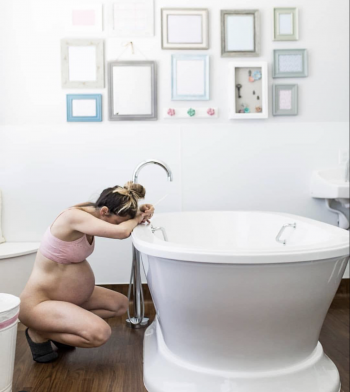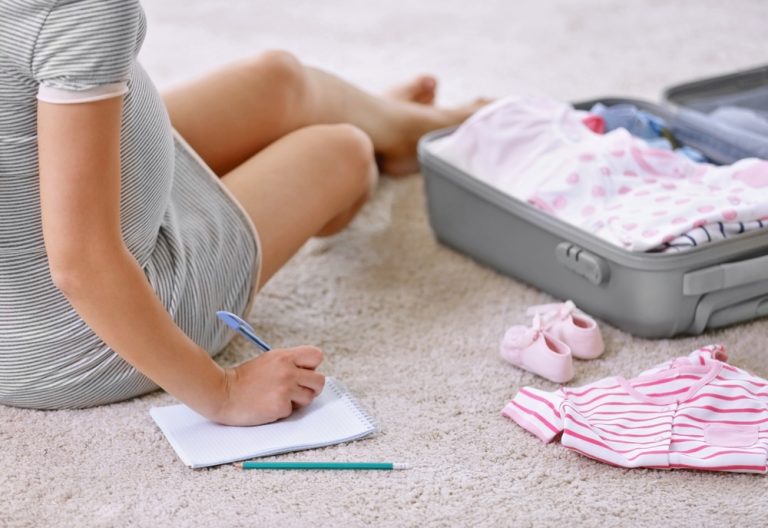7 Labor Positions You’re Sure to Love
Birth is a Labor of Love, But You Can Also Love Labor
Labor Day honors American workers — and for some women, the MOST laborious work they might experience happens outside the office. You guessed it, we’re talking about giving birth — more specifically, labor positions!

We’re using this end-of-summer holiday to honor the work it took for many of us to become mothers (and for all of us to come into the world)! Read on as we share our favorite labor positions. Sometimes the littlest things can make the biggest difference — and we can vouch for the following positions in helping ease the labor process for many mamas.
Studies show that moving around and utilizing upright positions during the first stage of labor (as opposed to laboring on your back) has measurable benefits. In a 2013 study, participants were put in two groups in a hospital setting. One group labored in upright positions and were able to move around during first stage labor. The other group remained in bed and labored on their backs. Findings revealed that first stage labor lasted an hour and 22 minutes shorter for those in the upright and free-movement position during labor. People in this group of the study were also less likely to ask for an epidural and less likely to necessitate cesarean sections.
Hands and Knees
The Hands and Knees position during labor looks just like it sounds. This is an especially beneficial position for women experiencing back labor as it takes some of the pressure off the back and also lets gravity do its work. It takes pressure off the aorta which can help increase oxygen flow to baby and mom.
This position also helps open the pelvis while also allowing mother to rest a bit, as opposed to being in a standing or squatting position.
This versatile position can take place in practically any birth setting: on a hospital bed, in the tub, on the floor, making it such a go-to position! One downside to this position is that it can lead to tired arms, but an easy modification takes care of that. Simply have Mom lean forward to rest her head on a pillow and drop her arms down to a child’s pose style position.
Birthing Ball
The birthing ball is such a versatile tool during pregnancy, labor and beyond! During labor, it also flexes its versatility muscles due to the many different positions you can utilize with it.
The birthing ball is a popular alternative to sitting in a seat or on the toilet, as its much more comfortable. It can also help get baby in the right position for pushing later down the road.
One common position is sitting on the birthing ball during labor. The cushion of the ball is especially popular because it helps moms move their hips with little effort, which can alleviate pain and discomfort. While sitting, there’s also the ability to sway, rock, bounce, make circles or a combination depending on what feels best during contractions and while resting.
Another way to use the birthing ball is by kneeling and leaning onto it for upper support. Some even lay their whole upper torsos on top of it while swaying or bouncing through contractions. The counter pressure of the ball can also feel nice when pressing the body against it.
The birthing ball also travels well, and as such, can work in a hospital setting, at a birth center, or home. As an added bonus, there’s a strong likelihood that you’ll find the birth ball useful with bouncing your baby to sleep!
Side-lying
Side-lying is a great position for resting, and one that you might use when you’re trying, and still able, to nap. That said, if able, its best to move more during early labor.
This position is a go-to for moms who are experiencing lengthy labors or if they are having trouble getting comfortable. Side-lying is especially helpful because it allows Mom to rest between contractions more easily, as opposed to contracting on a birthing ball. This pose also is helpful for women experiencing blood pressure issues, and to help get more oxygen flow to the baby.
Don’t let it’s restful posture fool you, there is still work going on with your body and baby when in the side-lying position — it just helps preserve energy, and prevent fatigue. When in this pose, its best to curve the body a little inward while in this position, like the fetal position.
Sitting and Straddling the Toilet
There’s a reason so many mamas labor on the toilet seat. It’s already a setting that elicits some sense of privacy (unless you’re already a parent, ha!). Since being potty trained, it also is the place we’ve learned to release and let go! Great associations to make when we’re thinking about birth.
Keeping all the above mental conveniences in mind, the toilet also has a lot of physical practicality based on it’s construction. It allows Mom to rest in a seated position, which again prompts gravity to take on some work for her. Sitting on the toilet also relaxes the perineum — a big plus to help prevent tearing!
This position is more common during active labor, and not necessary best for early on — when movement is beneficial. The toilet seat can also get a bit uncomfortable. To help, especially if Mom doesn’t want to move from this spot, have her straddle the seat and place pillow on top of the tank!
This is also a potential position for pushing as well.
Support Squat
Squatting during labor (and doing squats throughout pregnancy) is an excellent position and exercise to prepare for birth. It helps open up the pelvis, and provides the space for baby to ease naturally down the birth canal. Instinctively, it can feel like the most natural position to be in, as our ancestors birthed this way.
All the benefits sound great and all, but physically getting in a squat may sound not so easy, especially adding contractions and a pregnancy belly to the mix. That’s why we’ve included the “Support” part to this position.
Support can look a few different ways during labor. A laboring mom can use a birthing ball, holding onto it for support while coming down into a squat. She can also hold onto a chair, table top, or counter as she squats down. One of our favorite “supports” for the squat, though, is human-support. It’s a great opportunity to include the mother’s partner in the experience by having them either hold her underneath her armpits while she dangles. Another way is to have Mom lean into her partner while they hug or hold her.
One thing to keep in mind: It’s very important not to have the hands above the head too much though, as it can lead to dizziness, so be mindful of that!
The Lunge
First, squats. Now, lunges. Are we stressing you out with these back-to-back exercises? Hear us out — lunges might not be your favorite in a workout, but they can be such a great position for labor.
Lunging can help rotate or ease baby down and also opens up the pelvis. Moms have the flexibility to put their foot up on a chair or the stairs, and can use their partner or the wall for stability.
Your care provider might recommend lunges if labor has stalled, and its popular later in labor when the strength of contractions are intensified.
Slow Dance
Can you tell we can’t resist any opportunity to bring couples together, even (especially) during labor? This is why we LOVE the slow dance position.
You already know why remaining upright and moving during labor is so beneficial. It’s a lot more difficult as second stage labor approaches, which is why your care providers will encourage it in the beginning. That being said, it’s not the most comfortable thing to stand in place while you’re contracting.
The slow dance, or swaying, through contractions and in between helps get your hips moving and encourages baby to ease itself down. Having your partner hold you, maybe even apply counter pressure against your back as you do this, will also provide some emotional support and closeness to the experience. Labor is more mental than physical, so helping mom feel connected, loved and relaxed is especially important.
It’s worth noting that it’s really difficult to predict what position will feel best during labor. Learning about all the different options beforehand, however, helps arm you with a variety of possibilities. Try them out, practicing with your partner leading up to the big day, and you’re sure to have a little less to worry about when the time comes.
Are you currently pregnant? You can learn more extensively about utilizing labor positions during contractions, relaxation tips for in between, and more through our Bradley and Hypnobabies courses held regularly at Babies in Bloom.
So, Moms, if you’re still reading, we’d love to hear what labor positions were your favorite. Share in the comments below!





